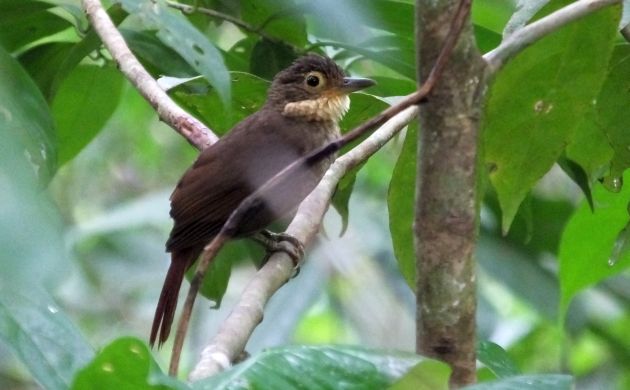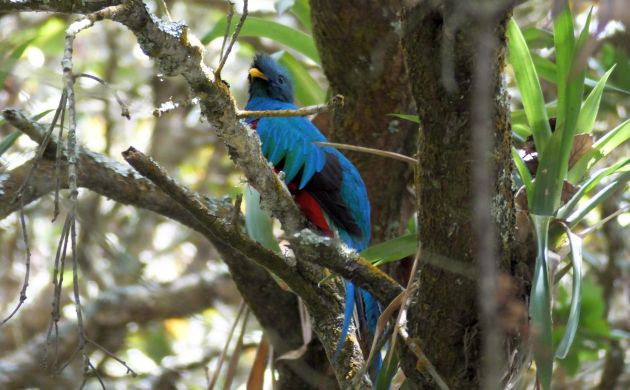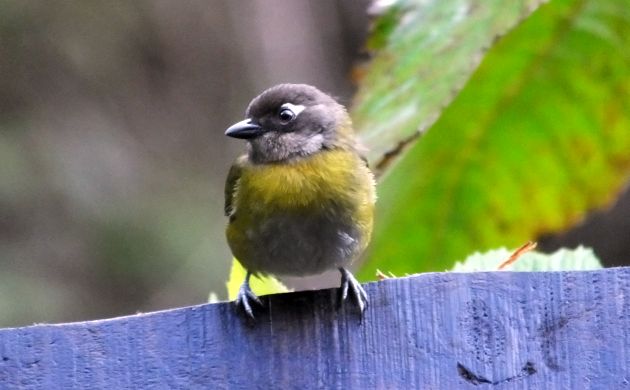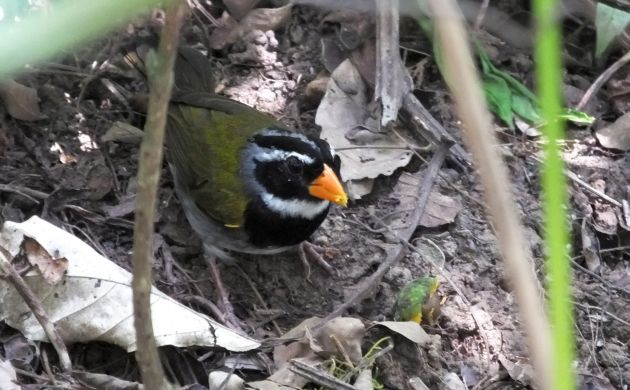
Birders head to Costa Rica to see stunners like Resplendent Quetzal, Three-wattled Bellbird, Orange-collared Manakin, fancy hummingbirds , tanagers, and literally hundreds of other birds.
One of them quetzals.
However, as you tick those tanagers, don’t forget to watch birds like House Wren, Nutting’s Flycatcher, and Bright-rumped Attila even if you have already seen them in other places. These and several other species might end up being armchair ticks if and when we take a closer look at their evolutionary history. Vocal differences are the most common hint that the taxon in question is a candidate for a split although most candidates also have varying degrees of morphological differences.
This bunch of possible Costa Rican crypto birds can be grouped into four main categories:
(1). Taxa that could end up being split into one species occurring north of the Isthmus of Tehuantepec, and one south of the isthmus.
(2). A species that lives in both Costa Rica and South America but might be two separate species.
(3). Two subspecies of the same species that differ within Costa Rica.
(4). Bird species that require further research.
The following are the species that seem to stand out the most when considering possible splits. Splits already recognized by the AOU as well as birds like “Mangrove Yellow Warbler are left out of the discussion because they are already well recognized as potential splits or even as separate species. I made this list based on personal observations from Costa Rica and South America, published studies, and the chance to study vocalizations shared at that fantastic bird vocalization resource known as Xeno-Canto (many thanks to http://www.xeno-canto.org for use of recordings embedded in this post).
1. Species that could end up being separate from the same species occurring north of the Isthmus of Tehuantepec-If you saw any of these north of Costa Rica, get ready to tick them again:
Clapper Rail: Thanks to the wonderful research and subsequent paper published by Maley and Brumfield (2013), we can now be pretty sure about the Clapper Rail being more than one species. However, the paper didn’t deal with birds from southern Central America. Since the authors didn’t have any specimens from this part of the world, we can’t blame them. Heck, Clapper Rail wasn’t even known from Costa Rica until recently. Based on even more recent recordings, it seems that the birds in Costa Rica can probably be placed in the Mangrove Rail group. For the birder, this means that no matter how many Clapper Rails you have seen in the salt marshes of New Jersey, North Carolina, or Texas, that Clapper Rail that lurks in the Black Mangroves at Chomes, Costa Rica is going to be a different species.
Check out recordings of Clapper Rail from North America and Costa Rica.
Black-faced Antthrush: According to the IOC list, this one is already split from the Mayan Antthrush of southern Mexico and northern Central America. Although you won’t find the Mayan Antthrush on the AOU list, the vocal differences between it and Black-faced Antthrushes from Costa Rica are quite pronounced. Try to see them both (as if anyone would not want to see something with as cool a name as “Mayan Antthrush”).
Listen to the difference between Mayan Antthrush and a Black-faced Antthrush from Costa Rica.
Northern Tufted Flycatcher: The birds north of the isthmus show some vocal differences compared to birds in Costa Rica. The same can be said about the population in Colombia and Ecuador so this could end up being a future, three-way split. A thorough molecular study should elucidate what’s going on with these cute little flycatchers.
I have yet to hear Costa Rican birds call like this one from Mexico. They sound more like this in Costa Rica.
Nutting’s Flycatcher: The fuzzy issue of the already tough to identify Nutting’s Flycatcher was brought to the attention of birders in 2013 by way of a proposal submitted to the AOU by Steve N. G. Howell. He argued that it should be split it into two species; one that occurs on the Pacific coastal plain from Mexico to northwestern Costa Rica, and another that also lives on the Pacific slope (but perhaps in the foothills?) from Mexico south to Costa Rica. Although the proposal failed to pass, more than one person who voted on it mentioned that Howell was probably right but that a more thorough study was needed. This means that there could very well be two species of Nutting’s type Flycatchers in Costa Rica. This means that we either ignore all of those dang Nutting’s Flycatchers or listen to every possible Nutting’s seen, take careful notes on plumage, and pay attention where you see them no matter what your guide says!
House Wren: Few birds garner more surprise from visiting North American birders than the local House Wrens. They don’t look a whole lot different from northern birds but their songs sure aren’t the same. The Northern versus Southern House Wren issue has been a long-standing conundrum for global birders. Pending an exhaustive study of the taxa involved, the birds in Costa Rica are still House Wrens but we might get an armchair tick one of these days. At least this is one that you don’t have to worry about NOT seeing when birding Costa Rica as they truly do love houses.
A House Wren from Costa Rica sings.
Common Chlorospingus: Yet another common bird that could be split into a bunch of species. Many people already view various populations in Mexico as separate species and studies might show that the same can be said about birds elsewhere in their range, including Costa Rica. Like the House Wren, you don’t have to worry about missing this one as long as you do even a half day of birding in middle-elevation forest. If it eventually gets its name changed, I hope that the new name still includes “Common” because it is far from rare.
A Common Chlorospingus from Costa Rica.
2. Bird species that live in both Costa Rica and South America but might be separate species:
White Hawk: Since the 2009 paper by Amaral, Sheldon, et al. showed that the White Hawk that occurs in the Amazon is the sister taxon of the Mantled Hawk and not the White Hawks from Middle America, you can bet that the ones you see in Costa Rica are not the same species as “White Hawks” from South America. Given that the dark mantled White Hawks from the Amazon look more like the equally dark backed Mantled Hawk, this shouldn’t too much of a surprise. So, if you saw a White Hawk on that trip to Cristalino Lodge, watch for White Hawk again in Costa Rica because we are talking about two different raptor ticks.
Buff-throated Foliage-gleaner: Ahh, the Buff-throated Foliage-gleaner. Widespread and looking pretty similar throughout its range but showing some very distinct vocal differences that probably point to two, three, or even four species. Two of those vocal groups are shown by birds in Costa Rica and neither of those are heard in South America. Whether birding in Costa Rica or elsewhere, get a good look at every one of these foliage-gleaners to be ready for the big split.
Buff-throated Foliage-gleaner from the Caribbean slope of Costa Rica. Amazonian birds sound like a miniature rainforest witch.
Long-tailed Woodcreeper: While the Long-taileds that live in the Amazon are easy enough to see, I wish I could say the same for the subspecies that occurs in Costa Rica! Maybe that difference comes from there actually being two species involved? Although detailed studies on the differences between the taxa in the Amazon and those in Central America have yet to be carried out, they don’t sound anything alike.
Check out the difference between a “Long-tailed Woodcreeper” from Costa Rica and a Long-tailed Woodcreeper from the Amazon.
Olivaceous Woodcreeper: This neotropical species has a huge range. In fact, it’s probably too big for just one little bird species because several distinct, very different vocalizations are known as well as plumage differences. That said, the birds from Costa Rica north to Mexico sound pretty much the same so they are probably the same species. Head to the southern continent though, and it’s best to get a look at every Olivaceous Woodcreeper you come across.
A typical Olivaceous Woodcreeper from Costa Rica. Now listen to one of those South American birds.
Tawny-throated Leaftosser: Like the Olivaceous Woodcreeper, this old taxon has a very large range. It also shows vocal differences in many areas and could be several species. In other words, it’s one of those serious headache future splits because figuring out what is going on with the evolutionary history of this secretive taxon will require sampling from many parts of its range. The ones in Costa Rica don’t sound like those in South America so keep that in mind if you have already seen it in, say, Southeastern Peru.
Tawny-throated Leaftosser from Costa Rica. One of the South American songs of Tawny-throated Leaftosser.
Striped Woodhaunter: Already known as “Western Woodhaunter” in some circles, this is a pretty good candidate as a split from the Striped (Eastern) Woodhaunter of Amazonia. If you see one in Costa Rica, it’s a Western. Once again, as with most of those brown-hued woodcreepers and Furnarids, the difference is experienced in song.
I hear this Western Woodhaunter song in rainforest in Costa Rica. This is what the woodhaunter sounds like in the Amazon.
Ochre-breasted Antpitta: Ok, I have to admit that I’m less sure about this one being different from the taxa often seen by birders in Mindo, Colombia, and Peru. However, this taxon got my attention because the description that Stiles and Skutch give for its call happens to be a trill. The few people I know who have actually seen this bird sing in Costa Rica have also all described a trill. This is in contrast to the typical short whistled call given by Ochre-breasted Antpittas from South America. Since the Grallaricula antpittas seem to fall into two vocal clades; one that gives trilling vocalizations and another that gives whistled calls, we need to take a closer look at the birds in Costa Rica. It might end up being the same species as the cute little antpittas in Mindo but then again who knows?
Black-faced Antthrush: Just as the Maya Antthrush sounds different from the birds in Costa Rica, so do the birds in Amazonia, Trinidad and Tobago, and the Guyanas. If you saw a Black-faced Antthrush on that trip to the Ecuadorian Amazon or Trinidad, make sure to see it again in Costa Rica (although Panamanian birds are probably the same species).
A Black-faced Antthrush from the Amazon.
Boat-billed Flycatcher: If you saw this one in the Amazon, see it again in Costa Rica because it might be different. It might not but birds in the Amazon (and perhaps elsewhere) show some vocal differences compared to those in Costa Rica.
I hear this Boat-billed Flycatcher call in Costa Rica. I recall this being the one given by Boat-billed Flycatcher in South America.
Ashy-throated Chlorospingus: Finally, a species for which sound doesn’t matter as much as plumage and range! It might not look like much but this uncommon species is a fair candidate as a split from the Ashy-throateds in South America. The subspecies that occurs in Costa Rica is only found in middle-elevation forests in Costa Rica and Panama and lacks the white line behind the eye shown by South American birds.
Bright-rumped Attila: This is a bird species for which vocal differences are fairly well known between Middle and South American populations. It might be split at some future time but that won’t happen until some brave ornithologist (or ambitious graduate student) carries out a big old study on this wide-ranging taxon.
Here is a Bright-rumped Attila in Costa Rica. Compared to the dawn song of Bright-rumped Attila from Amazonia.
3. Subspecies of the same species that differ within Costa Rica-try to see these species on both sides of the continental divide.
Buff-throated Foliage-gleaner: No not a case of déjà vu. We are back to this brown-themed bird because the two subspecies that occur in Costa Rica sound fairly different. Although more detailed playback experiments are required, a few preliminary ones I carried out showed support for the idea that there are two species of Buff-throated Foliage-gleaners in town. In other words, birds from the Caribbean slope did not respond to the songs of Pacific slope birds and vice versa.
A Caribbean slope Buff-throated Foliage-gleaner. Buff-throated Foliage-gleaner that range from Carara National Park south to Panama.
 A Buff-throated Foliage-gleaner from the Osa peninsula of Costa Rica.
A Buff-throated Foliage-gleaner from the Osa peninsula of Costa Rica.
Streak-chested Antpitta: I admit that this might be pushing things but the songs of birds on the Caribbean slope are a bit different from those on the Pacfic slope. Those Pacific slope birds sound more like the Streak-chested Antpittas from the Canal Zone in Panama south to northwestern Ecuador. These might not be different species but who knows, maybe molecular and morphological studies will find enough support to argue for their separation into two different species.
Song of Streak-chested Antpitta from the Caribbean slope of Costa Rica. Pacific slope Streak-chested Antpitta.
Orange-billed Sparrow: Another one that pushes the envelope (and even more so because we are dealing with a song-learning oscine) but since the songs of birds on the Caribbean slope are quite different from the tinkling songs of birds on the Pacific slope and further south to Panama and most areas in northwestern South America, might as well mention this one too.
Orange-billed Sparrow song from the Caribbean slope. The tinkling Orange-billed Sparrow song from the Pacific slope:
Orange-billed Sparrow looks the same pretty much everywhere.
4. Bird species that require further research and for which we need recordings. Although this could be said for just about about every bird species on our one and only Earth, the following are ones that make it to the top of this list in Costa Rica:
Prevost’s Ground Sparrow: Recent studies by Luis Sandoval of the Mennill lab have argued for recognizing the endemic subspecies in Costa Rica as a species separate from birds in northern Central America. Fantastic to see this because the bird only lives in a small part of Costa Rica and is endangered by massive conversion of already marginal habitat to urban areas.
Least Bittern: Recordings of Least Bitterns from North America seem to differ from those made in South America. The resident birds in Costa Rica seem to sound like ones from North America but it would be good to have more recordings available.
Black-banded Woodcreeper: We could really use more recordings of this one too, as well as from other sites in Middle America. I have only heard it once in Costa Rica and the vocalizations were much more like the long, sputtering calls given by this recording from the Monteverde area than by birds from Amazonia and other parts of South America.
Scaled Antpitta: Do birds in Costa Rica sound like ones from South America? How about Mexico? Please share the knowledge if you know! I have spent many a dawn at suitable spots in Costa Rica but have yet to hear one in this country.
References:
http://www.xeno-canto.org
Maley, J. M., and R. T. Brumfield. 2013. Mitochondrial and next-generation sequence data used to infer phylogenetic relationships and species limits in the Clapper/King Rail complex. Condor 115:316-329
RAPOSO DO AMARAL, F., F. H. SHELDON, A. GAMAUF, E. HARING, M. RIESING, L. F. SILVEIRA, AND A. WAJNTAL. 2009. Patterns and processes of diversification in a widespread and ecologically diverse avian group, the buteonine hawks (Aves, Accipitridae). Molecular Phylogenetics and Evolution 53: 703-715.
Stiles, G., and A, Skutch. A Guide To The Birds Of Costa Rica. 1989. (Illustrated by Dana Gardner). Comstock Publishing Associates/Cornell University Press: Ithaca
AOU 2013 proposals:
http://www.aou.org/committees/nacc/proposals/2013-B.pdf















Last post you shared a Snowcap. This post you shared a quetzal. Are you trying to torture Mike and me?
Seriously though, excellent post. It’s nice to have potential splits in your pocket.
Awesome article Pat! The House Wren is really interesting to me, the island subspecies are easy to see as different – Cozumel House Wren just gives such a different impression with larger size, pale breast, more prominent eyeline, long heavy bill and very different song. But the mainland groups are confusing!
On Scaled Antpitta, I really wonder. We still haven’t heard Scaled Antpitta and we only had the most fleeting of looks in Chiapas and Nicaragua. Here is a an interesting description of the song of a bird from north of the Isthmus, where they seem to be rare as hen’s teeth:
http://www.surfbirds.com/trip_report.php?id=192
Cheers!
Josh and Kathi
A lot to think about here. I tend to use my eyes more than my ears, so thinking about splits based on song and call is particularly challenging.
@Corey- Sorry about the torture. To ease the pain, come on back to Costa Rica so we can go to El Tapir to tick the Snowcao (or maybe Rancho Naturalista?) and then head straight to Paraiso de Quetzales.
@Donna- Yeah, a lot to digest. Stuff to keep in mind when birding in Costa Rica. Some of these may or may not be spilt (and there are a few other candidates) but I thought it would be good for birders to be aware of the possibilities.